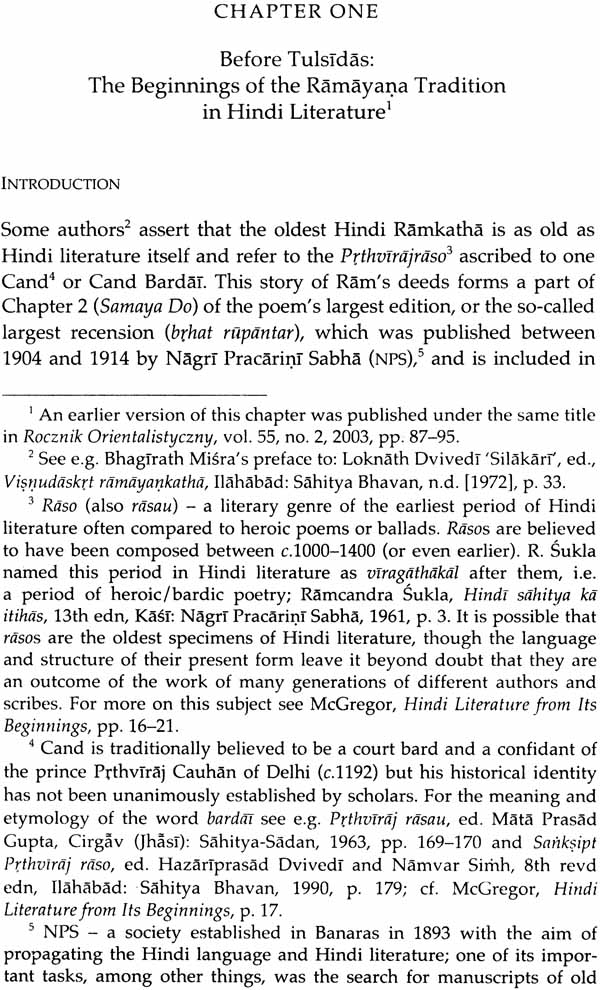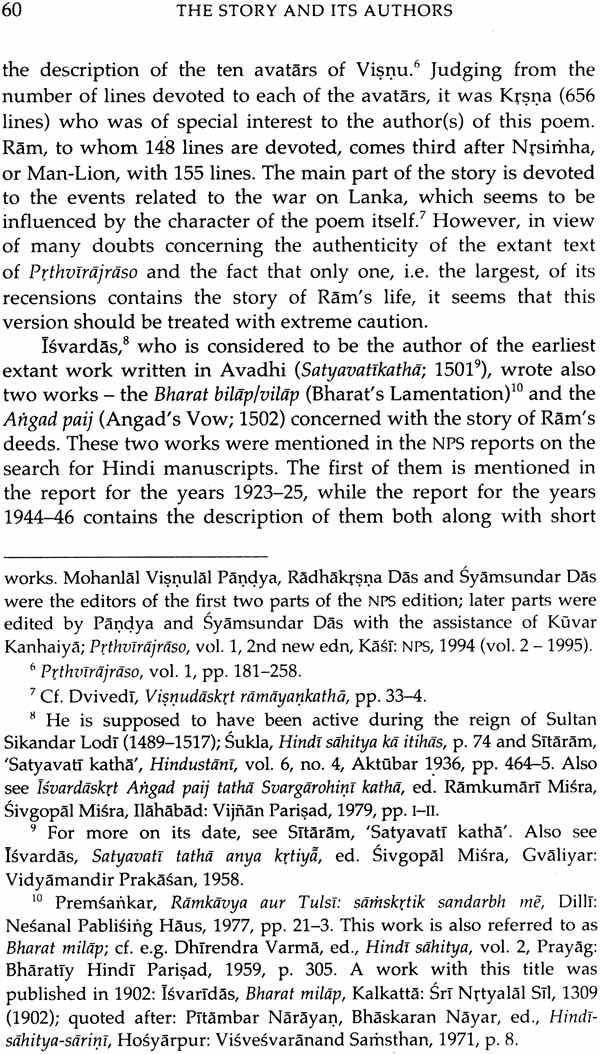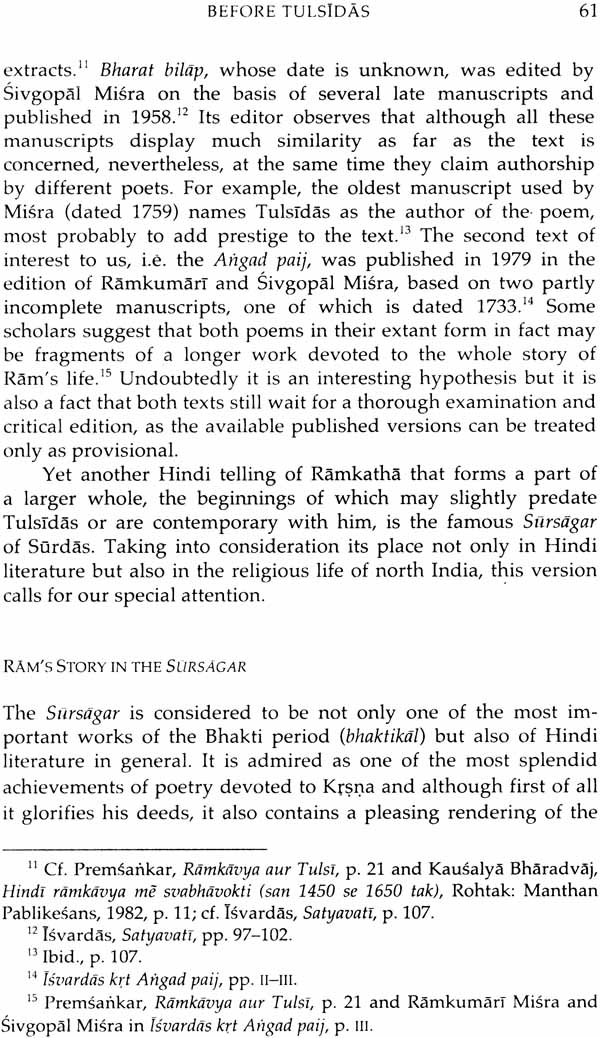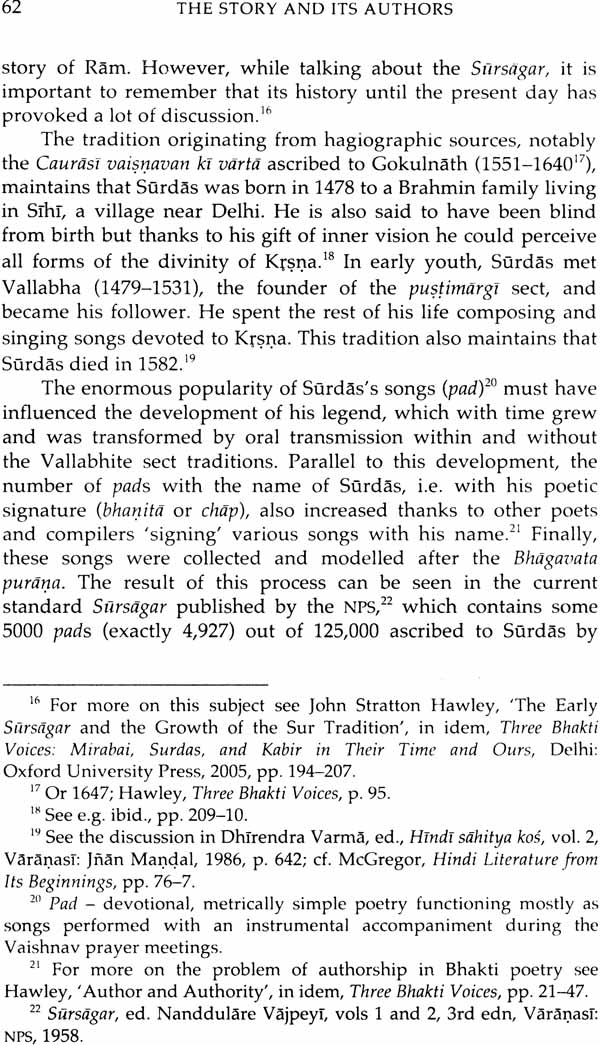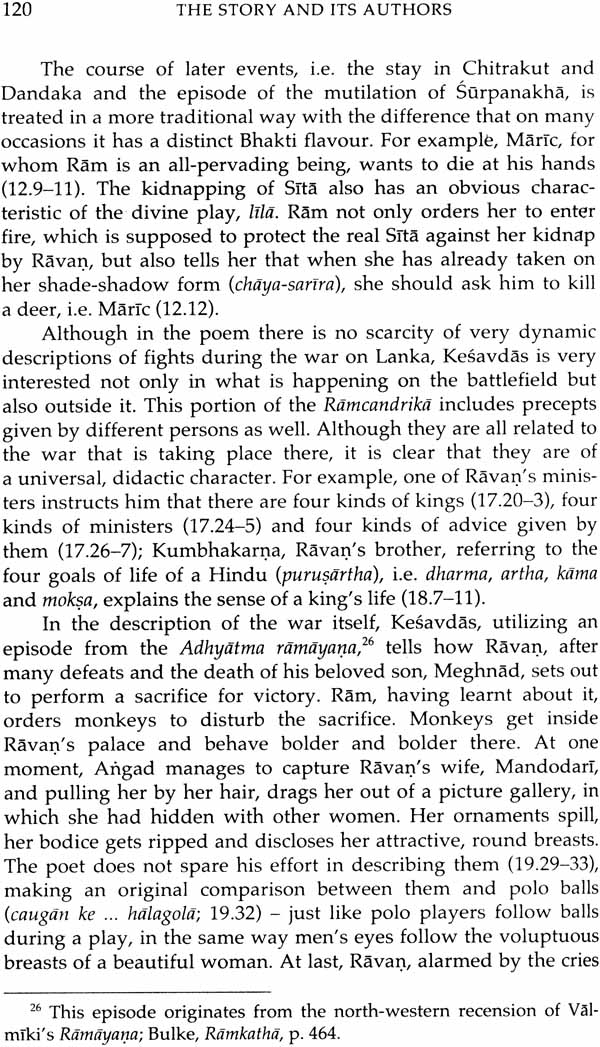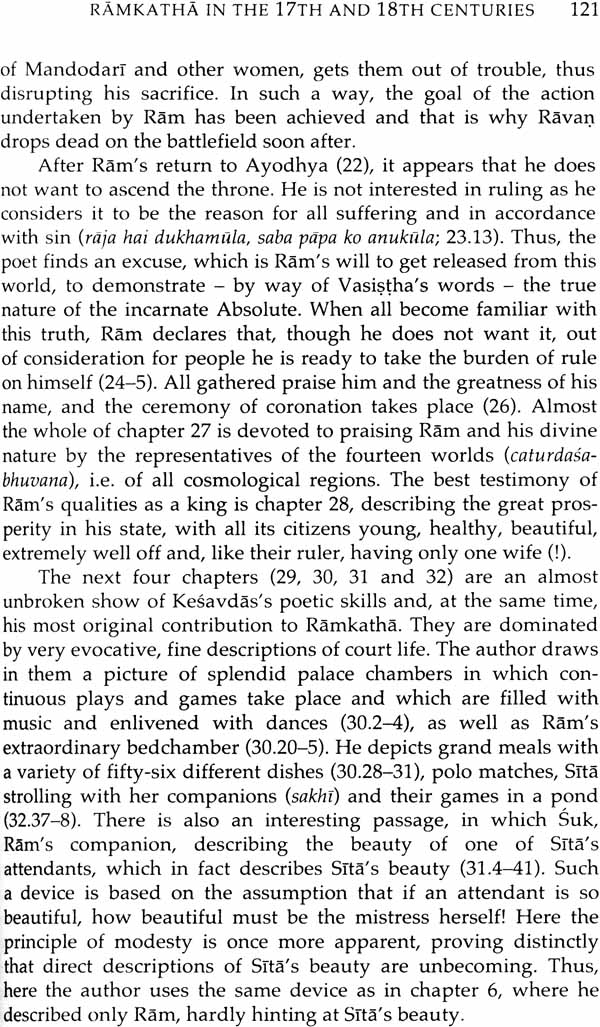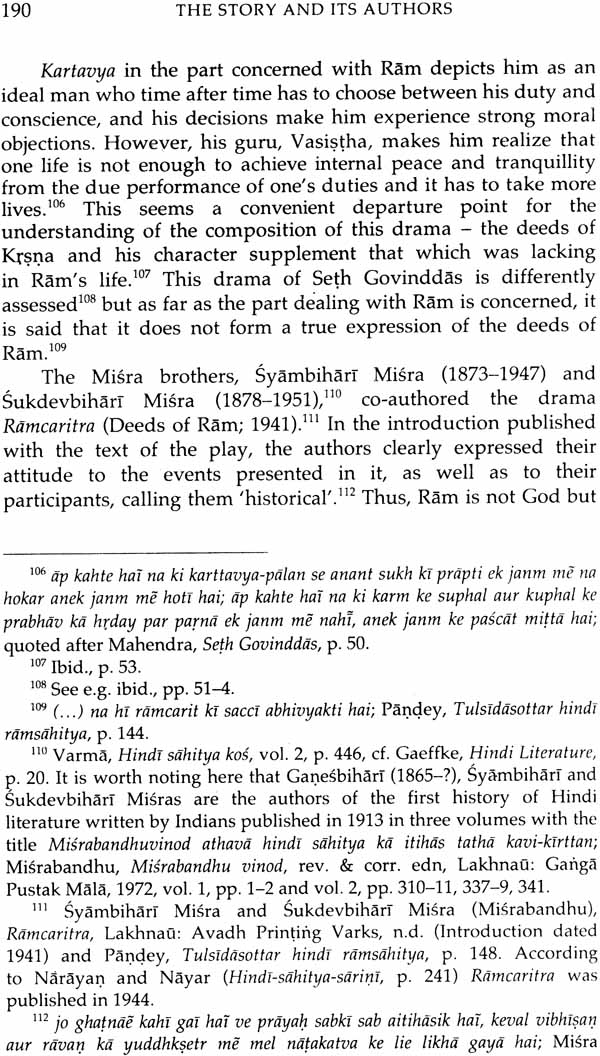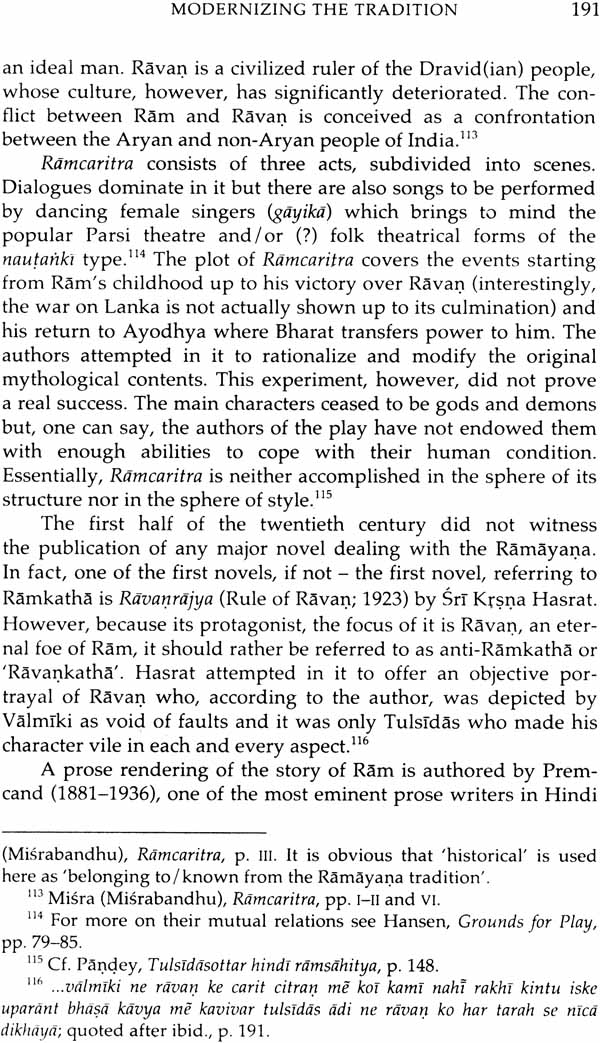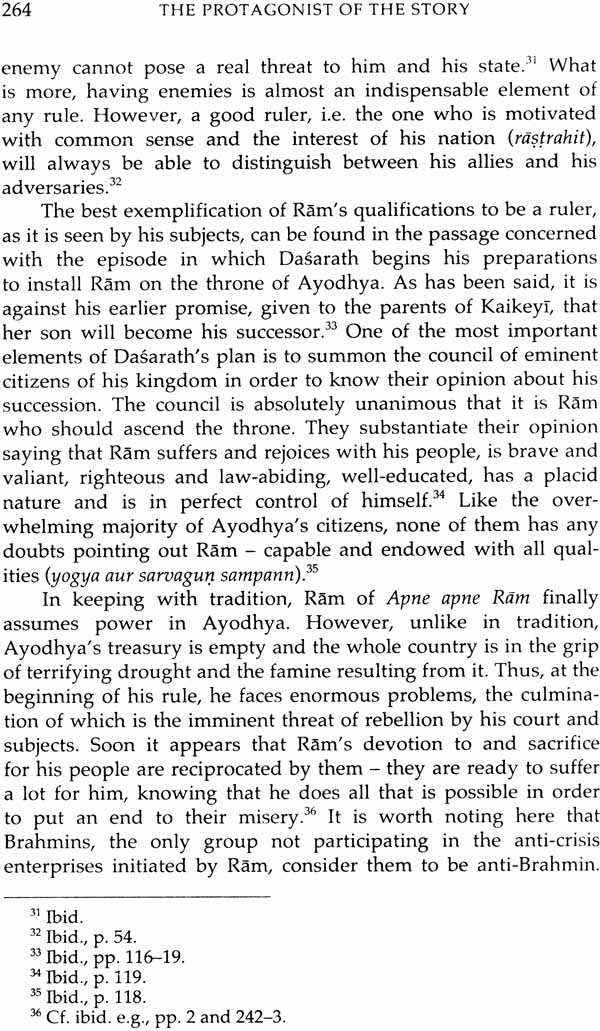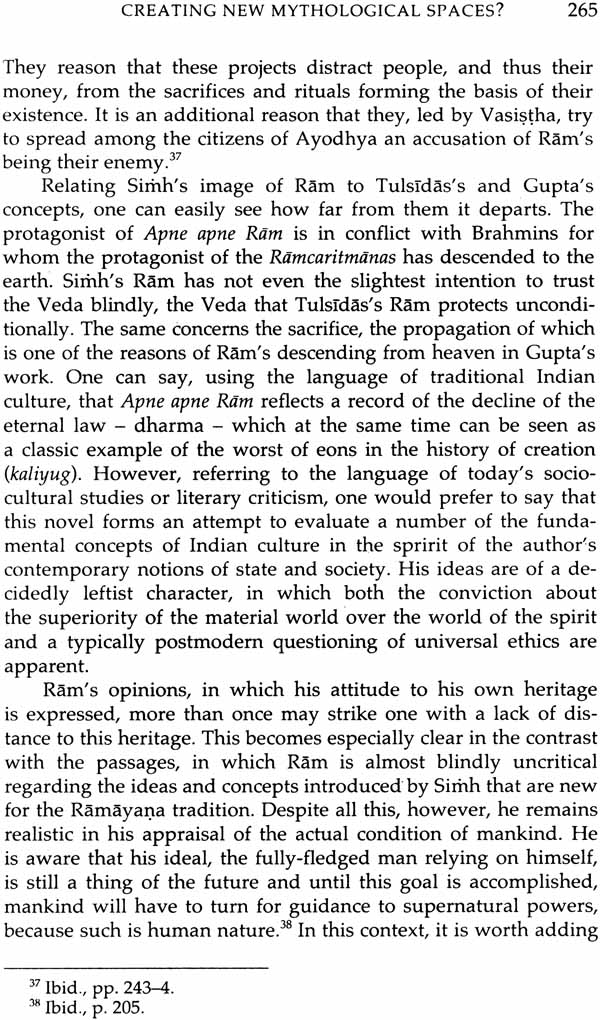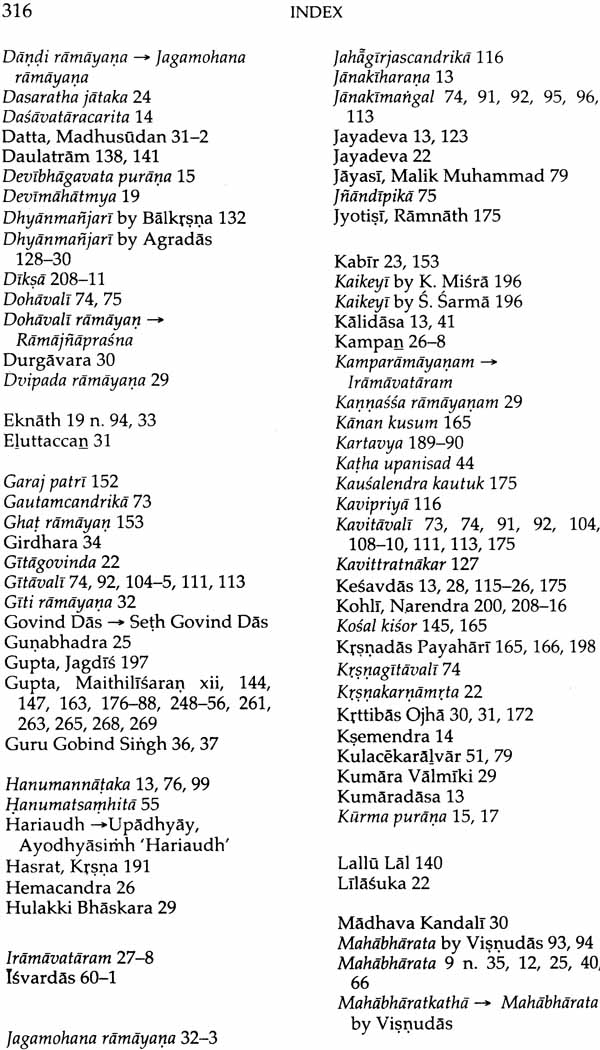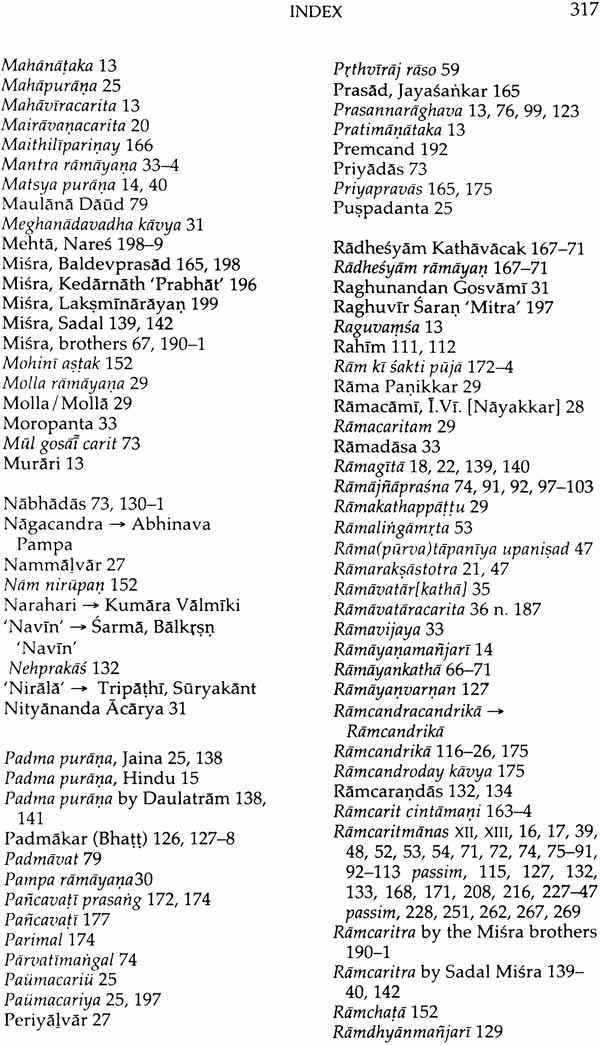
The Infinite Story: The Past and Present of The Ramayanas in Hindi
Book Specification
| Item Code: | NAE414 |
| Author: | Danuta Stasik |
| Publisher: | Manohar Publishers and Distributors |
| Language: | English |
| Edition: | 2009 |
| ISBN: | 9788173048159 |
| Pages: | 333 |
| Cover: | Hardcover |
| Other Details | 10.0 inch X 6.5 inch |
| Weight | 740 gm |
Book Description
The story of the Ramayana is well-known in all Indian languages and Hindi literature is no exception to it. It has a long and rich tradition based on Ramkatha that through the centuries has challenged many authors.
The main aim of this work is twofold. Firtsly, it seeks to analyse the development of the Ramayana tradition in Hindi literature from the perspective of its most important achievements against their historical background and socio-cultural context. Secondly, it attempts to examine the relationship between the story, i.e. Ramkatha, as told by different authors, and Ram, the protagonist of the Ramayana, who serves as model of right behavior for the others and at the same time appears to be one of the most important factors in the continuing popularity of the tradition.
The volume opens with an introduction that outlines the diversity of the Ramayana ascribed to the sage Valmiki. It discuses later developments in Sanskrit and vernacular literatures, as exemplified by their best achievements originating from Hindu, Buddhist and Jaina contexts. It also considers the implications of all these works for the un folding of the tradition in Hindi. In its closing portion, the volume provides an overview of the growth of the cult of Ram in north India.
This is an indispensable volume for scholars of Hinduism and north Indian cultural life.
Danuta Stasik is professor and Head of the Department of South Asian Studies, Faculty of Oriental Studies, University of Warsaw. Her research interests are the Rambhakti in north India and the Indian diaspora in the West (particulary as represented in Hindi writing).
She is the author and co-author of seven books, among them: Out of India: Image of the West in Hindi Literature (1994); a grammar of the Hindi language (in polish, 2nd edn 2008); a textbook of Hindi in two parts (in Polish, part 1-4th edn 2007 and part 2-2nd edn 2008), as well as of more than fifty articles published in different books and journals in Polish, English and Hindi. She is also Editor-in-Chief of a Polish journal Przeglad Orientalistyczny (oriental Review)
This book has' grown out of years of study on the Ramayana tradition in Hindi that over this period materialized in the form of different research papers and articles' as well as in my book Opounesc 0 prawym krolu, published in Polish.' which is the fullest exposition of the results of my enquiries into the Ramayana subject to date. The Infinite Story owes a great deal to Opoioiesc o prawym krolu particularly with regard to its basic approach and chief conclusions. However, it also includes new materials that have brought about new views and findings. In that sense, the present study is both a sum of my previous research and its sequel.
The main goals of this work are twofold. Firstly, it seeks to analyse the development of the Rarnayana tradition in Hindi literature from the perspective of its most important achievements against their historical background and socio-cultural context. Secondly, it attempts to examine the relationship between the story, i.e. Ramkatha, as told by different authors, and Ram, the protagonist of the Ramayana, who functions as a cultural hero and serves as a model of right behaviour for others and at the same time appears to be one of the most important factors in the continuing popularity of the tradition.
The focus of this analysis is, in principle, on the most im- portant - either because of their place in the annals of Hindi literature or their innovative approach to the story and / or its form, etc. - full versions of Ramkatha that are self-contained wholes and have appeared in print. This does not mean, however, that the works devoted to single episodes or forming a part of a larger whole have been ignored completely; they are referred to whenever they make a meaningful contribution to the development of the tradition. Nevertheless, works by different authors belonging to different periods that have remained in manuscript form have not been an object of my investigation. Although I have no doubt that a detailed analysis of such manuscripts can yield interesting results, nevertheless, it goes far beyond the scope of this study.
This book opens with an Introduction that outlines the diversity of the Rarnayana tradition in India, beginning with the first-known Ramauana ascribed to the sage Valmlki. It discusses later developments in Sanskrit and vernacular literatures, as exemplified by their best achievements originating from Hindu,Buddhist and aina contexts. It also considers the implications of all these works for the unfolding of the tradition in Hindi. In its closing portion, it gives an overview of the growth of the cult of Ram in north India. Special attention is paid to Bhakti that has shaped the countenance of the religious life in north India and has found a splendid expression in the magnum opus of Tulsidas, the sixteenth-century Ramcaritmanas.
The main core of this study is divided into two interrelated parts. Part One, 'The Story and Its Authors', consists of six chapters that are devoted to the examination of the most representative Ramkathas in the entire history of Hindi literature, which have been selected according to the already discussed criteria. This investigation becomes especially challenging with reference to teUings written by modern authors in which case the problem of their attitude to the myth of Ram, and to myth in general, becomes of great importance. In regard to this question, I have chosen to refer to Eleazar Meletinsky's findings put forward in his book Poeiika mifa.
Part Two, 'The Protagonist of the Story', is comprised of three chapters and concentrates on the image of Ram present in Hindi literature. This analysis is based on three works that emerge from the survey carried out in Part One as the most interesting and typical of their times. Firstly, I am concerned with the image of Ram in the Ramcariimanas. Secondly, I deal with the character of the protagonist of Maithilisaran Gupta's Saket considered to be the best example of Hindi literature at the time of the national movement with regard to different retellings of Ramkatha and, thirdly, the figure of Ram from Bhagvan Sirnh's novel Apne apne Ram, the most discussed - in Hindi literary circles - of contemporary Ramkathas. In my analysis, I view Ram not only as a literary figure but also as a cultural hero, one who shows others how to lead a proper life. I believe that such an approach based on literary sources may contribute much to our understanding of the significance of Ram in north Indian culture.
At the end, I have provided Appendices with a summary of the story and a glossary of the names in Tulstdas's Ramcariimanas.
Throughout these years, this work has gathered a lot of debt often difficult to acknowledge fully as help of different kinds came from various sources. However, there are several individuals to whom I owe much more than words can covey. First of all, I would like to thank Kunwar Narain, to whom I have dedicated this book, for introducing me to Ayodhya, as well as to his wife, Bharati, and their son, Apurva. Over the years, they have provided me with family like support that can never be overestimated. I am also much obliged to Bimlendra Mohan Pratap Mishra of Ayodhya and his family for making my work in Ayodhya an enjoyable and unforgettable experience. My heartfelt thanks also go to Jacek Wozniak who read the entire manuscript and to Eric Baker for correcting my English.
The last credit goes to Staszek and Michalina, as well as to other loved ones, without whom no work would seem meaningful.
This study contains many words from Hindi but also from Sanskrit and, to a lesser extent, from other Indian languages. In general, they have been written following the rules common among scholars dealing with these languages. However, it should be stressed that because I have used materials that belong to different linguistic epochs and regions, I have not hesitated to alter-nate between the spellings of words typical of Sanskrit and of different forms of Hind? in order to match them to their relevant context.
Thus, when dealing with Sanskrit literature, I have adapted the spelling 'Rarna' (as well as Siva or purusoitama, etc.), while in the case of Hindi and in the modern context - 'Ram' (as well as Siv or purusotiam, etc.). However, in order not to multiply forms, I have decided to give preference to the non-italicized form 'Ramayana' throughout the book, wherever I mean the Ramayana tradition and refer to no particular title. Its italicized form has been used in the titles of particular Sanskrit works, e.g. 'the Ramauana of Valmlki', while in Hindi titles it has additionally dropped the final 'a', becoming thus Ramaqan. 4
Some Indian words have become common in English and I have rendered them in their anglicized spellings, e.g. 'Brahmin', the same in the case of geographical names and all Indian words that have appeared in the passages translated by me from Hindi into English (the transliterations of the originals have been given for the reader's convenience in the footnotes). Thus, 'Ram' or 'Siv' used in the analysis may appear next to 'Ram' and 'Shiv' in the English translation. The use of capital letters in the transliterated titles of original works has been restricted to the first word and personal names, with the only exception of the name 'Ram(a)': in the transliterated passages no capital letters have been used at all.
As a rule, I have italicized Indian terms (but not the names of individuals-imaginary and real) used in the English text of the analysis with the exception of those that I have used more frequently.
| Preface | XI |
| Introduction | |
| Multiple Streams of the Ramayana Tradition | 1 |
| Introductory Remarks | 1 |
| The Beginings: Valmiki's Ramayana | 3 |
| Character of the Poem and its Hero | 5 |
| A few Remarks on the Popularity of the Ramayana | 8 |
| The Development of the Tradition in India | 12 |
| Sanskrit | 12 |
| Buddhist and Jaina Tellings | 24 |
| Ramayana in Regional Languages of India | 26 |
| Notes on the Cult of Ram (Rambhakti) | 38 |
| Introduction | 38 |
| Bhakti | 42 |
| Rambhakti in North India | 46 |
| Rasik Sampraday or Esoteric Rambhakti | 48 |
| Part One: The Story And Its Authors | |
| Chapter One | |
| Before Tulsidas : The Beginings of the Ramayana Tradition in Hindi Literature | 59 |
| Introduction | 59 |
| Ram's Story in the Sursagar | 61 |
| Vinsudas and His Ramayan: Thr Poet's Life and Works | 66 |
| Chapter Two | |
| In the World of Tulsidas's Ramkathas | 72 |
| Introductory Remarks on Tulsidas's Life and Works | 72 |
| The Ramcaritmanas | 75 |
| Introductory Remarks | 75 |
| The Poem's structure | 77 |
| Popularity of the Ramcaritmanas | 87 |
| Beyond the Ramcartimanas | 91 |
| The Ramlalanahacha and the Janakimangal | 92 |
| Ask Ram for Assistance-Ramkatha as a Method of Divination | 97 |
| Glory-songs of Raghunath': The Gitavali, the Vinaypatrika the Kavitavali and the Barvai ramayan | 104 |
| Conclusions | 112 |
| Chapter Three | |
| Ramkatha in the Seventeenth and Eighteenth Centuries: | |
| In the Shawdow of Tulsidas? | 115 |
| Introductory Remarks | 115 |
| Artistry of Kesavdas | 115 |
| The poet and His Works | 115 |
| Moonlit' Ramkatha of the Ramcandrika | 117 |
| Characteristic Features of the Ramcandrika | 123 |
| Esoteric Ramkathas | 128 |
| Conclusions | 133 |
| Chapter Four | |
| On the Thershold of Modernity: Ramkathas in the Nineteenth Century | 135 |
| Transformation of Language and Form | 135 |
| Hindi Ramayanas as the Earliest Examples of hindi porse | 138 |
| Esoteric Influences | 141 |
| Anand Raghunandan: The First Modern Hindi Drama | 141 |
| Introductory Remarks | 141 |
| The plot, the structure and Dramatis Personae | 143 |
| Anand Raghunandan as the First Hindi Drama | |
| An Appraisal | 146 |
| Conclusions | 147 |
| Banadas: A Nineteenth-century Singer of Ram's Glory | 149 |
| Ubhay prbodhak ramayan: Double Illumination of Ramkatha | 154 |
| Conclusions | 160 |
| Chapter Five | |
| Modernizing the Tradition: Ramkathas of the First Half of the Twentieth Century | 162 |
| Introduction: Contextualizing Ramkathas | 162 |
| Transforming Poetical Utterance | 163 |
| Maithilisaran Gupta's Saket | 176 |
| Introduction | 176 |
| How Saket Was Written | 177 |
| How Saket Is Written | 179 |
| Why Saket. | 183 |
| Urmila, Saket and Ramkatha | 184 |
| Saket's Appraisal | 187 |
| Drama and Novel | 188 |
| Conclusions | 193 |
| Chapter Six | |
| Ramkathas of the Second Half of the Twentieth Century | 195 |
| Introduction | 195 |
| Ramkatha in Contemporary hindi poetry and Drama | 196 |
| Ramkatha in the Contemporary Novel | 201 |
| Introductory Notes on Myth in Literature | 201 |
| Catursen Sastris Vayam raksamah | 205 |
| The Ramkatha Cycle by Narendra Kohli | 208 |
| Bhagvan Simh's Apne apne Ram | 216 |
| Simh's Ramkatha | 217 |
| Towards a New Myth? | 220 |
| Conclusions | 222 |
| Part Two: The Protagonist Of The Story | |
| Chapter Seven | |
| On the Nature of Tulsidas's Ram | 227 |
| Introduction | 227 |
| The Incarnate Absolute | 230 |
| Divine Aspects | 230 |
| Human aspect | 236 |
| Ram the king | 241 |
| Chapter Eight | |
| The Heaven on Earth Builder: Ram in Gupta's Saket | 248 |
| Chapter Nine | |
| Creating New Mythological Spaces? On Tradition, Society and the Role of People in Bhagvan simh's Apne apne Ram | 257 |
| The Infinite Story? | |
| Conclusions | |
| Appendices | |
| Appendix A: A summary of the story in Tulsidas's | |
| Ramcartimanas | 273 |
| Appendix B: Names of the Major Characters and places in the Ramcaritmanas | 286 |
| Bibliography | 293 |
| Index | 315 |
